Display glacier area and thickness changes on a grid#
from oggm import cfg
from oggm import tasks, utils, workflow, graphics, DEFAULT_BASE_URL
import salem
import xarray as xr
import numpy as np
import glob
import os
import matplotlib.pyplot as plt
This notebook proposes a method for redistributing glacier ice that has been simulated along the flowline after a glacier retreat simulation. Extrapolating the glacier ice onto a map involves certain assumptions and trade-offs. Depending on the purpose, different choices may be preferred. For example, higher resolution may be desired for visualization compared to using the output for a hydrological model. It is possible to add different options to the final function to allow users to select the option that best suits their needs.
This notebook demonstrates the redistribution process using a single glacier. Its purpose is to initiate further discussion before incorporating it into the main OGGM code base (currently, it is in the sandbox).
Pick a glacier#
# Initialize OGGM and set up the default run parameters
cfg.initialize(logging_level='WARNING')
# Local working directory (where OGGM will write its output)
# WORKING_DIR = utils.gettempdir('OGGM_distr4')
cfg.PATHS['working_dir'] = utils.get_temp_dir('OGGM_distributed', reset=True)
2024-04-25 13:17:52: oggm.cfg: Reading default parameters from the OGGM `params.cfg` configuration file.
2024-04-25 13:17:52: oggm.cfg: Multiprocessing switched OFF according to the parameter file.
2024-04-25 13:17:52: oggm.cfg: Multiprocessing: using all available processors (N=4)
rgi_ids = ['RGI60-11.01450', # Aletsch
'RGI60-11.01478'] # Fieschergletscher
gdirs = workflow.init_glacier_directories(rgi_ids, prepro_base_url=DEFAULT_BASE_URL, from_prepro_level=4, prepro_border=80)
2024-04-25 13:17:54: oggm.workflow: init_glacier_directories from prepro level 4 on 2 glaciers.
2024-04-25 13:17:54: oggm.workflow: Execute entity tasks [gdir_from_prepro] on 2 glaciers
Experiment: a random warming simulation#
Here we use a random climate, but you can use any GCM, as long as glaciers are getting smaller, not bigger!
# Do a random run with a bit of warming
workflow.execute_entity_task(
tasks.run_random_climate,
gdirs,
ys=2020, ye=2100, # Although the simulation is idealised, lets use real dates for the animation
y0=2009, halfsize=10, # Random climate of 1999-2019
seed=1, # Random number generator seed
temperature_bias=1.5, # additional warming - change for other scenarios
store_fl_diagnostics=True, # important! This will be needed for the redistribution
init_model_filesuffix='_spinup_historical', # start from the spinup run
output_filesuffix='_random_s1', # optional - here I just want to make things explicit as to which run we are using afterwards
);
2024-04-25 13:17:55: oggm.workflow: Execute entity tasks [run_random_climate] on 2 glaciers
Redistribute: preprocessing#
The required tasks can be found in the distribute_2d module of the sandbox:
from oggm.sandbox import distribute_2d
# This is to add a new topography to the file (smoothed differently)
workflow.execute_entity_task(distribute_2d.add_smoothed_glacier_topo, gdirs)
# This is to get the bed map at the start of the simulation
workflow.execute_entity_task(tasks.distribute_thickness_per_altitude, gdirs)
# This is to prepare the glacier directory for the interpolation (needs to be done only once)
workflow.execute_entity_task(distribute_2d.assign_points_to_band, gdirs);
2024-04-25 13:17:56: oggm.workflow: Execute entity tasks [add_smoothed_glacier_topo] on 2 glaciers
2024-04-25 13:17:56: oggm.workflow: Execute entity tasks [distribute_thickness_per_altitude] on 2 glaciers
2024-04-25 13:17:58: oggm.workflow: Execute entity tasks [assign_points_to_band] on 2 glaciers
Let’s have a look at what we just did:
gdir = gdirs[0] # here for Aletsch
#gdir = gdirs[1] # uncomment for Fieschergletscher
with xr.open_dataset(gdir.get_filepath('gridded_data')) as ds:
ds = ds.load()
# Inititial glacier thickness
f, ax = plt.subplots()
ds.distributed_thickness.plot(ax=ax);
ax.axis('equal');
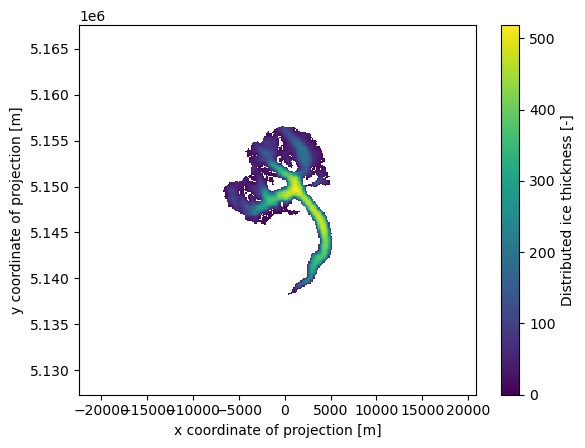
# Which points belongs to which band, and then within one band which are the first to melt
f, (ax1, ax2) = plt.subplots(1, 2, figsize=(12, 4))
ds.band_index.plot.contourf(ax=ax1);
ds.rank_per_band.plot(ax=ax2);
ax1.axis('equal'); ax2.axis('equal'); plt.tight_layout();

Redistribute simulation#
The tasks above need to be run only once. The next one however should be done for each simulation:
ds = workflow.execute_entity_task(
distribute_2d.distribute_thickness_from_simulation,
gdirs,
input_filesuffix='_random_s1', # Use the simulation we just did
concat_input_filesuffix='_spinup_historical', # Concatenate with the historical spinup
output_filesuffix='', # filesuffix added to the output filename gridded_simulation.nc, if empty input_filesuffix is used
)
2024-04-25 13:17:58: oggm.workflow: Execute entity tasks [distribute_thickness_from_simulation] on 2 glaciers
Plot#
Let’s have a look!
# # This below is only to open the file again later if needed
# with xr.open_dataset(gdir.get_filepath('gridded_simulation', filesuffix='_random_s1')) as ds:
# ds = ds.load()
def plot_distributed_thickness(ds, title):
f, (ax1, ax2, ax3) = plt.subplots(1, 3, figsize=(14, 4))
ds.simulated_thickness.sel(time=2005).plot(ax=ax1, vmax=400);
ds.simulated_thickness.sel(time=2050).plot(ax=ax2, vmax=400);
ds.simulated_thickness.sel(time=2100).plot(ax=ax3, vmax=400);
ax1.axis('equal'); ax2.axis('equal'); f.suptitle(title, fontsize=20);
plt.tight_layout();
plot_distributed_thickness(ds[0], 'Aletsch')
# plot_distributed_thickness(ds[1], 'Fieschergletscher')

Note: the simulation before the RGI date cannot be trusted - it is the result of the dynamical spinup. Furthermore, if the area is larger than the RGI glacier, the redistribution algorithm will put all mass in the glacier mask, which is not what we want:
def plot_area(ds, gdir, title):
area = (ds.simulated_thickness > 0).sum(dim=['x', 'y']) * gdir.grid.dx**2 * 1e-6
area.plot(label='Distributed area');
plt.hlines(gdir.rgi_area_km2, gdir.rgi_date, 2100, color='C3', linestyles='--', label='RGI Area');
plt.legend(loc='lower left'); plt.ylabel('Area [km2]'); plt.title(title, fontsize=20); plt.show();
plot_area(ds[0], gdirs[0], 'Aletsch')
# plot_area(ds[1], gdirs[1], 'Fieschergletscher')
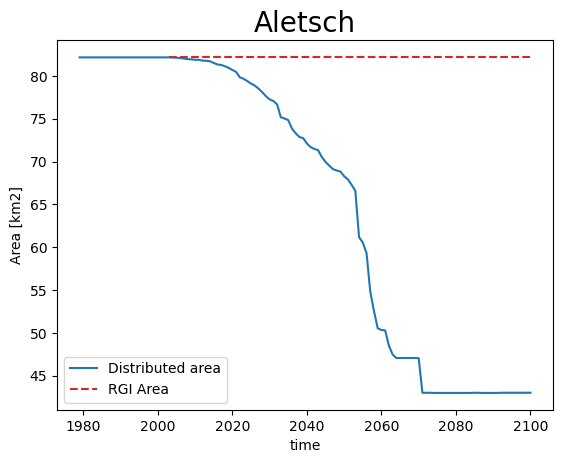
Volume however is conserved:
def plot_volume(ds, gdir, title):
vol = ds.simulated_thickness.sum(dim=['x', 'y']) * gdir.grid.dx**2 * 1e-9
vol.plot(label='Distributed volume'); plt.ylabel('Distributed volume [km3]');
plt.title(title, fontsize=20); plt.show();
plot_volume(ds[0], gdirs[0], 'Aletsch')
# plot_volume(ds[1], gdirs[1], 'Fieschergletscher')
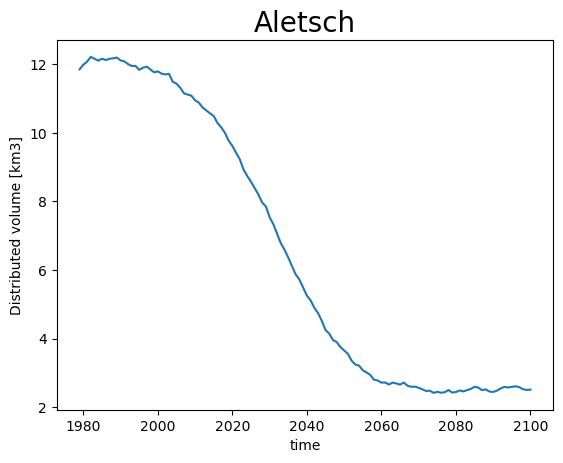
Therefore, lets just keep all data after the RGI year only:
for i, (ds_single, gdir) in enumerate(zip(ds, gdirs)):
ds[i] = ds_single.sel(time=slice(gdir.rgi_date, None))
Animation!#
from matplotlib import animation
from IPython.display import HTML, display
# Get a handle on the figure and the axes
fig, ax = plt.subplots()
thk = ds[0]['simulated_thickness'] # Aletsch
# thk = ds[1]['simulated_thickness'] # Fieschergletscher
# Plot the initial frame.
cax = thk.isel(time=0).plot(ax=ax,
add_colorbar=True,
cmap='viridis',
vmin=0, vmax=thk.max(),
cbar_kwargs={
'extend':'neither'
}
)
ax.axis('equal')
def animate(frame):
ax.set_title(f'Year {int(thk.time[frame])}')
cax.set_array(thk.values[frame, :].flatten())
ani_glacier = animation.FuncAnimation(fig, animate, frames=len(thk.time), interval=100);
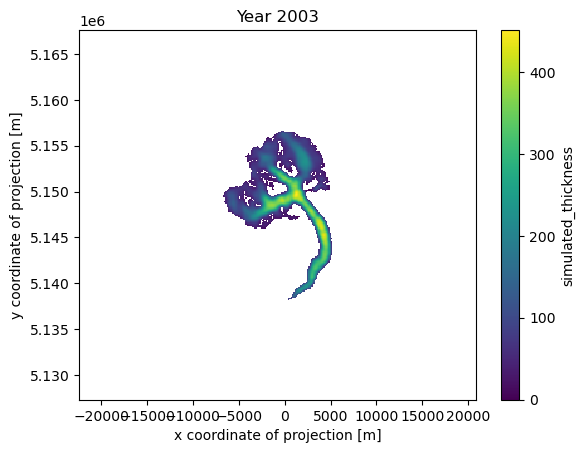
HTML(ani_glacier.to_jshtml())
# Write to mp4?
# FFwriter = animation.FFMpegWriter(fps=10)
# ani2.save('animation.mp4', writer=FFwriter)
Finetune the visualisation#
When applying the tools you might see that sometimes the timeseries are “shaky”, or have sudden changes in area. This comes from a few reasons:
OGGM does not distinguish between ice and snow, i.e. when it snows a lot sometimes OGGM thinks there is a glacier for a couple of years.
the trapezoidal flowlines result in sudden (“step”) area changes when they melt entirely.
on small glaciers, the changes within one year can be big, and you may want to have more intermediate frames
We implement some workarounds for these situations:
ds_smooth = workflow.execute_entity_task(
distribute_2d.distribute_thickness_from_simulation,
gdirs,
input_filesuffix='_random_s1',
concat_input_filesuffix='_spinup_historical',
ys=2003, ye=2100, # make the output smaller
output_filesuffix='_random_s1_smooth', # do not overwrite the previous file (optional)
# add_monthly=True, # more frames! (12 times more - we comment for the demo, but recommend it)
rolling_mean_smoothing=7, # smooth the area time series
fl_thickness_threshold=1, # avoid snow patches to be nisclassified
)
2024-04-25 13:18:17: oggm.workflow: Execute entity tasks [distribute_thickness_from_simulation] on 2 glaciers
def plot_area_smoothed(ds_smooth, ds, gdir, title):
area = (ds.simulated_thickness > 0).sum(dim=['x', 'y']) * gdir.grid.dx**2 * 1e-6
area.plot(label='Distributed area (raw)');
area = (ds_smooth.simulated_thickness > 0).sum(dim=['x', 'y']) * gdir.grid.dx**2 * 1e-6
area.plot(label='Distributed area (smooth)');
plt.legend(loc='lower left'); plt.ylabel('Area [km2]');
plt.title(title, fontsize=20); plt.show();
plot_area_smoothed(ds_smooth[0], ds[0], gdirs[0], 'Aletsch')
# plot_area_smoothed(ds_smooth[1], ds[1], gdirs[1], 'Fieschergletscher')
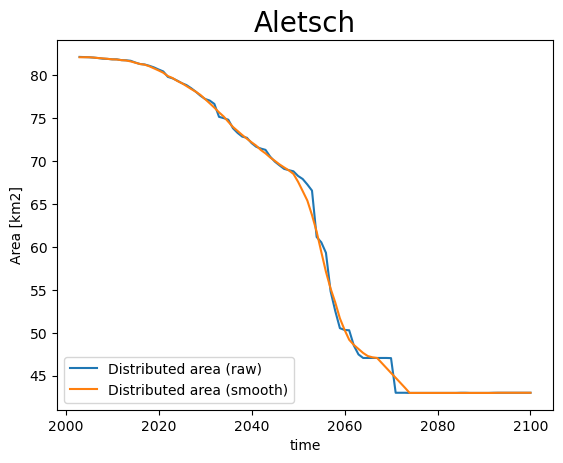
# Get a handle on the figure and the axes
fig, ax = plt.subplots()
thk = ds_smooth[0]['simulated_thickness'] # Aletsch
# thk = ds_smooth[1]['simulated_thickness'] # Fieschergletscher
# Plot the initial frame.
cax = thk.isel(time=0).plot(ax=ax,
add_colorbar=True,
cmap='viridis',
vmin=0, vmax=thk.max(),
cbar_kwargs={
'extend':'neither'
}
)
ax.axis('equal')
def animate(frame):
ax.set_title(f'Year {float(thk.time[frame]):.1f}')
cax.set_array(thk.values[frame, :].flatten())
ani_glacier = animation.FuncAnimation(fig, animate, frames=len(thk.time), interval=100);
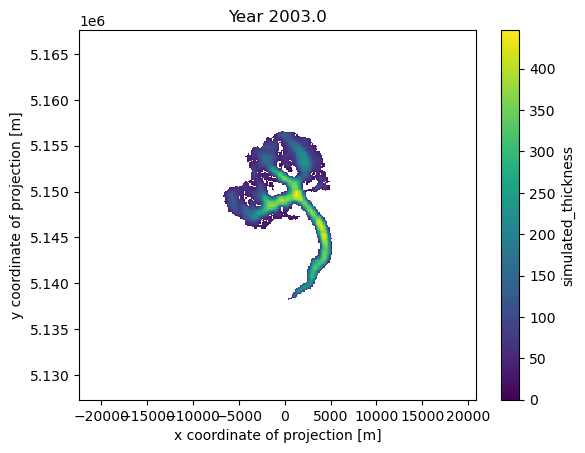
# Visualize
HTML(ani_glacier.to_jshtml())
# Write to mp4?
# FFwriter = animation.FFMpegWriter(fps=120)
# ani2.save('animation_smooth.mp4', writer=FFwriter)
Merge redistributed thickness from multiple glaciers#
If you’re working in a region with multiple glaciers, displaying the evolution of all glaciers simultaneously can be convenient. To facilitate this, we offer a tool that merges the simulated distributed thicknesses of multiple glaciers.
This process can be very memory-intensive. To prevent memory overflow issues, we, by default, merge the data for each year into a separate file. If you have sufficient resources, you can set save_as_multiple_files=False to compile the data into a single file at the end. However, with xarray.open_mfdataset, you have the capability to seamlessly open and work with these multiple files as if they were one.
For further explanation on merging gridded_data, please consult the tutorial Ingest gridded products such as ice velocity into OGGM.
simulation_filesuffix = '_random_s1_smooth' # saved in variable for later opening of the files
distribute_2d.merge_simulated_thickness(
gdirs, # the gdirs we want to merge
simulation_filesuffix=simulation_filesuffix, # the name of the simulation
years_to_merge=np.arange(2005, 2101, 5), # for demonstration I only pick some years, if this is None all years are merged
add_topography=True, # if you do not need topogrpahy setting this to False will decrease computing time
preserve_totals=True, # preserve individual glacier volumes during merging
reset=True,
)
2024-04-25 13:18:33: oggm.sandbox.distribute_2d: Applying global task merge_simulated_thickness on 2 glaciers
2024-04-25 13:18:33: oggm.workflow: Applying global task merge_gridded_data on 2 glaciers
---------------------------------------------------------------------------
ModuleNotFoundError Traceback (most recent call last)
File /usr/local/pyenv/versions/3.11.9/lib/python3.11/site-packages/oggm/utils/_downloads.py:538, in _progress_urlretrieve(url, cache_name, reset, auth, timeout)
537 try:
--> 538 from progressbar import DataTransferBar, UnknownLength
539 pbar = None
ModuleNotFoundError: No module named 'progressbar'
During handling of the above exception, another exception occurred:
HttpDownloadError Traceback (most recent call last)
Cell In[24], line 2
1 simulation_filesuffix = '_random_s1_smooth' # saved in variable for later opening of the files
----> 2 distribute_2d.merge_simulated_thickness(
3 gdirs, # the gdirs we want to merge
4 simulation_filesuffix=simulation_filesuffix, # the name of the simulation
5 years_to_merge=np.arange(2005, 2101, 5), # for demonstration I only pick some years, if this is None all years are merged
6 add_topography=True, # if you do not need topogrpahy setting this to False will decrease computing time
7 preserve_totals=True, # preserve individual glacier volumes during merging
8 reset=True,
9 )
File /usr/local/pyenv/versions/3.11.9/lib/python3.11/site-packages/oggm/utils/_workflow.py:553, in global_task.__call__.<locals>._global_task(gdirs, **kwargs)
549 self.log.workflow('Applying global task %s on %s glaciers',
550 task_func.__name__, len(gdirs))
552 # Run the task
--> 553 return task_func(gdirs, **kwargs)
File /usr/local/pyenv/versions/3.11.9/lib/python3.11/site-packages/oggm/sandbox/distribute_2d.py:503, in merge_simulated_thickness(gdirs, output_folder, output_filename, simulation_filesuffix, years_to_merge, keep_dem_file, interp, preserve_totals, smooth_radius, use_glacier_mask, add_topography, use_multiprocessing, save_as_multiple_files, reset)
499 ds.to_netcdf(fp)
501 if save_as_multiple_files:
502 # first the _topo_data file
--> 503 workflow.merge_gridded_data(
504 gdirs,
505 output_folder=output_folder,
506 output_filename=f"{output_filename}_topo_data",
507 input_file='gridded_data',
508 input_filesuffix='',
509 included_variables=['glacier_ext',
510 'glacier_mask',
511 'distributed_thickness',
512 ],
513 preserve_totals=preserve_totals,
514 smooth_radius=smooth_radius,
515 use_glacier_mask=use_glacier_mask,
516 add_topography=add_topography,
517 keep_dem_file=keep_dem_file,
518 interp=interp,
519 use_multiprocessing=use_multiprocessing,
520 return_dataset=False,
521 reset=reset)
523 # recalculate bed topography after reprojection, if topo was added
524 if add_topography:
File /usr/local/pyenv/versions/3.11.9/lib/python3.11/site-packages/oggm/utils/_workflow.py:553, in global_task.__call__.<locals>._global_task(gdirs, **kwargs)
549 self.log.workflow('Applying global task %s on %s glaciers',
550 task_func.__name__, len(gdirs))
552 # Run the task
--> 553 return task_func(gdirs, **kwargs)
File /usr/local/pyenv/versions/3.11.9/lib/python3.11/site-packages/oggm/workflow.py:981, in merge_gridded_data(gdirs, output_folder, output_filename, input_file, input_filesuffix, included_variables, preserve_totals, smooth_radius, use_glacier_mask, add_topography, keep_dem_file, interp, use_multiprocessing, return_dataset, reset)
979 dem_source = None
980 dem_gdir = gdirs[0]
--> 981 gis.get_dem_for_grid(combined_grid, output_folder,
982 source=dem_source, gdir=dem_gdir)
983 # unwrapped is needed to execute process_dem without the entity_task
984 # overhead (this would need a valid gdir)
985 gis.process_dem.unwrapped(gdir=None, grid=combined_grid,
986 fpath=output_folder,
987 output_filename=output_filename)
File /usr/local/pyenv/versions/3.11.9/lib/python3.11/site-packages/oggm/core/gis.py:482, in get_dem_for_grid(grid, fpath, source, gdir)
471 grid_prop = {
472 'utm_proj': grid.proj,
473 'dx': grid.dx,
(...)
477 'ny': grid.ny
478 }
480 source = check_dem_source(source, extent_ll, rgi_id=rgi_id)
--> 482 dem_list, dem_source = get_topo_file((minlon, maxlon), (minlat, maxlat),
483 gdir=gdir,
484 dx_meter=grid_prop['dx'],
485 source=source)
487 if rgi_id is not None:
488 log.debug('(%s) DEM source: %s', rgi_id, dem_source)
File /usr/local/pyenv/versions/3.11.9/lib/python3.11/site-packages/oggm/utils/_downloads.py:2487, in get_topo_file(lon_ex, lat_ex, gdir, dx_meter, zoom, source)
2485 zones = nasadem_zone(lon_ex, lat_ex)
2486 for z in zones:
-> 2487 files.append(_download_nasadem_file(z))
2489 # filter for None (e.g. oceans)
2490 files = [s for s in files if s]
File /usr/local/pyenv/versions/3.11.9/lib/python3.11/site-packages/oggm/utils/_downloads.py:895, in _download_nasadem_file(zone)
893 def _download_nasadem_file(zone):
894 with get_lock():
--> 895 return _download_nasadem_file_unlocked(zone)
File /usr/local/pyenv/versions/3.11.9/lib/python3.11/site-packages/oggm/utils/_downloads.py:915, in _download_nasadem_file_unlocked(zone)
912 return outpath
914 # Did we download it yet?
--> 915 dest_file = file_downloader(wwwfile)
917 # None means we tried hard but we couldn't find it
918 if not dest_file:
File /usr/local/pyenv/versions/3.11.9/lib/python3.11/site-packages/oggm/utils/_downloads.py:606, in file_downloader(www_path, retry_max, sleep_on_retry, cache_name, reset, auth, timeout)
604 try:
605 retry_counter += 1
--> 606 local_path = _progress_urlretrieve(www_path, cache_name=cache_name,
607 reset=reset, auth=auth,
608 timeout=timeout)
609 # if no error, exit
610 break
File /usr/local/pyenv/versions/3.11.9/lib/python3.11/site-packages/oggm/utils/_downloads.py:562, in _progress_urlretrieve(url, cache_name, reset, auth, timeout)
560 return res
561 except ImportError:
--> 562 return oggm_urlretrieve(url, cache_obj_name=cache_name,
563 reset=reset, auth=auth, timeout=timeout)
File /usr/local/pyenv/versions/3.11.9/lib/python3.11/site-packages/oggm/utils/_downloads.py:530, in oggm_urlretrieve(url, cache_obj_name, reset, reporthook, auth, timeout)
526 _classic_urlretrieve(url, cache_path, reporthook, auth,
527 timeout)
528 return cache_path
--> 530 return _verified_download_helper(cache_obj_name, _dlf, reset)
File /usr/local/pyenv/versions/3.11.9/lib/python3.11/site-packages/oggm/utils/_downloads.py:336, in _verified_download_helper(cache_obj_name, dl_func, reset)
329 def _verified_download_helper(cache_obj_name, dl_func, reset=False):
330 """Helper function for downloads.
331
332 Verifies the size and hash of the downloaded file against the included
333 list of known static files.
334 Uses _cached_download_helper to perform the actual download.
335 """
--> 336 path = _cached_download_helper(cache_obj_name, dl_func, reset)
338 dl_verify = cfg.PARAMS.get('dl_verify', False)
340 if dl_verify and path and cache_obj_name not in cfg.DL_VERIFIED:
File /usr/local/pyenv/versions/3.11.9/lib/python3.11/site-packages/oggm/utils/_downloads.py:320, in _cached_download_helper(cache_obj_name, dl_func, reset)
317 mkdir(os.path.dirname(cache_path))
319 try:
--> 320 cache_path = _call_dl_func(dl_func, cache_path)
321 except BaseException:
322 if os.path.exists(cache_path):
File /usr/local/pyenv/versions/3.11.9/lib/python3.11/site-packages/oggm/utils/_downloads.py:262, in _call_dl_func(dl_func, cache_path)
259 def _call_dl_func(dl_func, cache_path):
260 """Helper so the actual call to downloads can be overridden
261 """
--> 262 return dl_func(cache_path)
File /usr/local/pyenv/versions/3.11.9/lib/python3.11/site-packages/oggm/utils/_downloads.py:521, in oggm_urlretrieve.<locals>._dlf(cache_path)
519 logger.info("Downloading %s to %s..." % (url, cache_path))
520 try:
--> 521 _requests_urlretrieve(url, cache_path, reporthook, auth, timeout)
522 except requests.exceptions.InvalidSchema:
523 if 'ftps://' in url:
File /usr/local/pyenv/versions/3.11.9/lib/python3.11/site-packages/oggm/utils/_downloads.py:376, in _requests_urlretrieve(url, path, reporthook, auth, timeout)
374 with requests.get(url, stream=True, auth=auth, timeout=timeout) as r:
375 if r.status_code != 200:
--> 376 raise HttpDownloadError(r.status_code, url)
377 r.raise_for_status()
379 size = r.headers.get('content-length') or -1
HttpDownloadError: (401, 'https://e4ftl01.cr.usgs.gov/MEASURES/NASADEM_HGT.001/2000.02.11/NASADEM_HGT_n46e007.zip')
# by default the resulting files are saved in cfg.PATHS['working_dir']
# with names gridded_simulation_merged{simulation_filesuffix}{yr}.
# To open all at once we first get all corresponding files
files_to_open = glob.glob(
os.path.join(
cfg.PATHS['working_dir'], # the default output_folder
f'gridded_simulation_merged{simulation_filesuffix}*.nc', # with the * we open all files which matches the pattern
)
)
files_to_open
[]
You will notice that there is a file for each year, as well as one file with the suffix _topo_data. As the name suggests, this file contains the topography and gridded-outline information of the merged glaciers, which could be useful for visualizations.
Now we open all files in one dataset with:
with xr.open_mfdataset(files_to_open) as ds_merged:
ds_merged = ds_merged.load()
---------------------------------------------------------------------------
OSError Traceback (most recent call last)
Cell In[26], line 1
----> 1 with xr.open_mfdataset(files_to_open) as ds_merged:
2 ds_merged = ds_merged.load()
File /usr/local/pyenv/versions/3.11.9/lib/python3.11/site-packages/xarray/backends/api.py:1021, in open_mfdataset(paths, chunks, concat_dim, compat, preprocess, engine, data_vars, coords, combine, parallel, join, attrs_file, combine_attrs, **kwargs)
1018 paths = _find_absolute_paths(paths, engine=engine, **kwargs)
1020 if not paths:
-> 1021 raise OSError("no files to open")
1023 if combine == "nested":
1024 if isinstance(concat_dim, (str, DataArray)) or concat_dim is None:
OSError: no files to open
ds_merged
---------------------------------------------------------------------------
NameError Traceback (most recent call last)
Cell In[27], line 1
----> 1 ds_merged
NameError: name 'ds_merged' is not defined
Now we can look at the result with a plot:
plot_distributed_thickness(ds_merged, 'Aletsch and Fieschergletscher')
---------------------------------------------------------------------------
NameError Traceback (most recent call last)
Cell In[28], line 1
----> 1 plot_distributed_thickness(ds_merged, 'Aletsch and Fieschergletscher')
NameError: name 'ds_merged' is not defined
Alternatively, you can create an animation using the merged data, displaying a value every 5 years, as specified above with years_to_merge:
# Get a handle on the figure and the axes
fig, ax = plt.subplots()
thk = ds_merged['simulated_thickness']
# Plot the initial frame.
cax = thk.isel(time=0).plot(ax=ax,
add_colorbar=True,
cmap='viridis',
vmin=0, vmax=thk.max(),
cbar_kwargs={
'extend':'neither'
}
)
ax.axis('equal')
def animate(frame):
ax.set_title(f'Year {float(thk.time[frame]):.1f}')
cax.set_array(thk.values[frame, :].flatten())
ani_glacier = animation.FuncAnimation(fig, animate, frames=len(thk.time), interval=200);
---------------------------------------------------------------------------
NameError Traceback (most recent call last)
Cell In[29], line 4
1 # Get a handle on the figure and the axes
2 fig, ax = plt.subplots()
----> 4 thk = ds_merged['simulated_thickness']
6 # Plot the initial frame.
7 cax = thk.isel(time=0).plot(ax=ax,
8 add_colorbar=True,
9 cmap='viridis',
(...)
13 }
14 )
NameError: name 'ds_merged' is not defined
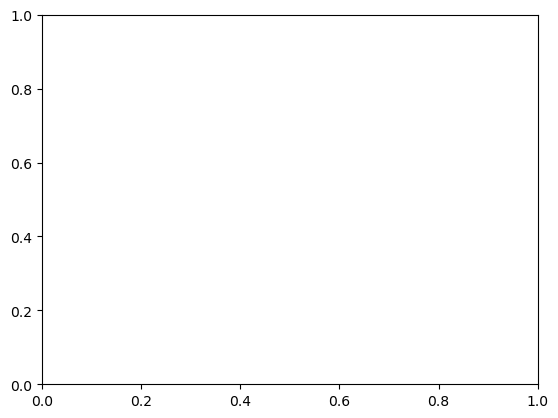
# Visualize
HTML(ani_glacier.to_jshtml())
For visualization purposes, the merged dataset also includes the topography of the entire region, encompassing the glacier surfaces:
cmap=salem.get_cmap('topo')
ds_merged.topo.plot(cmap=cmap)
---------------------------------------------------------------------------
NameError Traceback (most recent call last)
Cell In[31], line 2
1 cmap=salem.get_cmap('topo')
----> 2 ds_merged.topo.plot(cmap=cmap)
NameError: name 'ds_merged' is not defined
Or the estimated bedrock topography, without ice:
ds_merged.bedrock.plot(cmap=cmap)
---------------------------------------------------------------------------
NameError Traceback (most recent call last)
Cell In[32], line 1
----> 1 ds_merged.bedrock.plot(cmap=cmap)
NameError: name 'ds_merged' is not defined
Nice 3D videos#
We are working on a tool to make even nicer videos like this one:
from IPython.display import Video
Video("../../img/mittelbergferner.mp4", embed=True, width=700)
The WIP tool is available here: OGGM/oggm-3dviz


